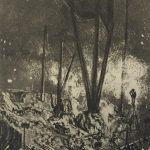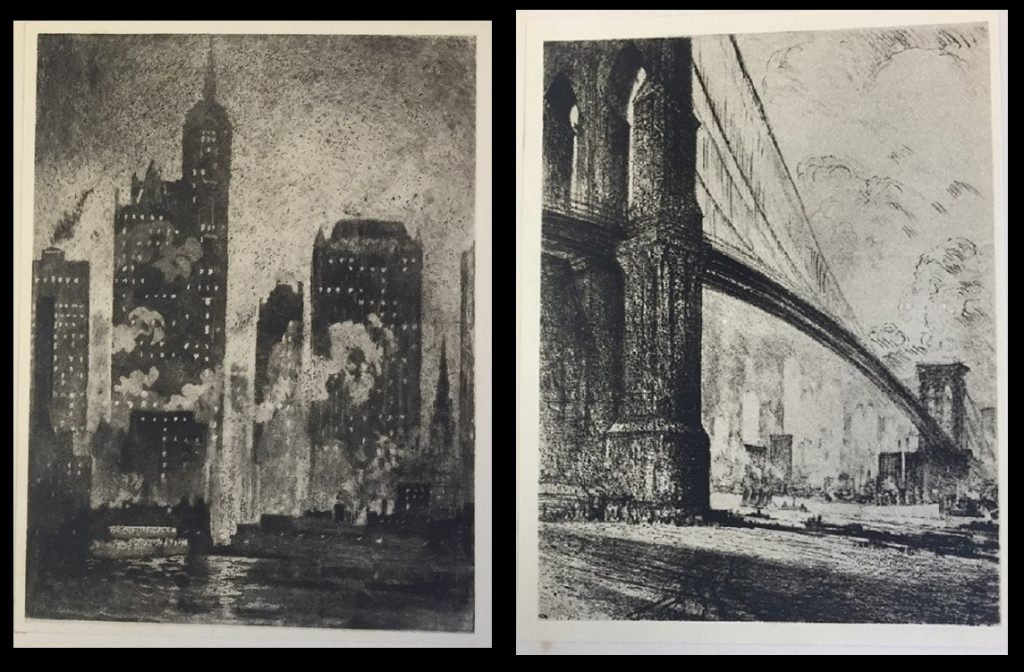Written by Louise Cowan, Trainee Liaison Librarian
One of the world’s top tourist destinations, New York has been attracting travellers for many years. This week’s Travel Thursday looks at the Big Apple from two uniquely different perspectives; that of a poet and that of an artist.
Australian born critic and poet, W.J. Turner (1889-1946) moved to London to pursue writing in 1907 and alongside friend, Siegfried Sassoon, became a member of the Georgian poets group when his work was published as part of a Georgian Poet anthology (Hawkes, 2004). Turner visited New York in the 1920s and penned a short travelogue detailing his time there, giving his thoughts on the city and all manner of related topics including, the wonderful character of American women, the Americanisation of Europe and advice on the perfect piece of luggage, the American trunk:
a trunk which stands upright, can be pushed along on rollers, fits in beside the driver of a taxi […] so easily accessible that he need never unpack during his whole journey.
American artist, Joseph Pennell (1857-1926) was an eminent etcher and lithographer, who championed and revived the art of print making in the early 20th Century (Encyclopedia Britannica, 2016). Although he travelled widely, Pennell lived in New York from 1918-1926 (Library of Congress, 2016) and created several beautiful drawings of the city.
For Pennell, New York was the ‘Unbelievable City’, a marvel of the modern world owing to its immense size and towering buildings, which are beautifully captured in his sketch of the city’s magnificent skyline.
Turner too is immediately in awe at the sight of New York on the horizon; on his arrival he proclaims:
There is no thrill at the end of any voyage upon this planet like the thrill at the first sight of New York rising like a bed of rock crystals out of the sea.
However, on closer inspection, Turner’s opinion of the city is not always the most enthusiastic, the smell he ascribes it for example is, “a blending of ice-cream and patchouli – a sickly mixture,” and he describes the general atmosphere as a terrifying mixture of noisy traffic and towering sky scrapers
that vomit, “from six to ten thousand people into the street,” all accompanied by a constant series of explosions caused by the underground work on subways and building foundations. The heavy building programme in New York during the 1920s was also captured by Pennell, though instead of complaining about the noise he marvels at the speed at which the skyscrapers are completed:
The work goes on by night as well as by day. A few months will see a skyscraper in place, equipped and occupied.
Both men also differ on their views of the iconic Statue of Liberty; for Pennell it is an “effective feature,” which “greets the incoming ships from the sea” while for Turner, the statue is decidedly, “stumpy and ungraceful.”
Turner further complains about his subway journey, describing the carriages as, “small, cheaply fitted, sordid, and uncomfortable,” whereas Pennell praises the linked elevated railway as a “pleasant mode of conveyance outside the rush hours.” However, despite his spirited complaining, Turner does give some interesting insights into the New York of the 1920s, for example although he dislikes the experience; he does explain how the subway system works:
To get quickly up-town it is necessary to take the subway. You go underground. There is an office where you can get change and then, putting in a nickel (five cents), you pass through clanging turnstiles on to the platform. There are no ticket collectors nor porters.
and he provides this description of the newly implemented, modern marvel – traffic lights:
Red and green lamps are placed on pillars at these intersections and by them traffic is regulated. In broad daylight up until 2a.m. these green and red lights are flashing in the streets. All the accidents – as a taxi driver explained to me – take place after 2 a.m.
Also, according to Turner, one of the advantages of such a large city that swarms with people is the anonymity and indifference afforded to its visitors:
There is in New York no public opinion, no curiosity. The complete impersonality of the big hotel and the big store where no one watches you to see that you spend something is very soothing.
Although only small details, you begin to get a vivid impression of a busy, crowded city that is full potential and growth. It is a city of the future and indeed it inspired Turner to philosophise about progress and the future of cities and civilisation. In his musings Turner even predicts the invention of mobile phones:
it is possible for me to predict that in much less than a hundred years from now one will be able to speak to any person in any part of the world by just taking a wireless receiver and transmitter out of one’s coat pocket.
Overall, regardless of its traffic and noise, both Turner and Pennell recognised that it is the architectural beauty of New York that really shines, it is a city designed to inspire and amaze and delight:
The sky-scrapers were slender pinnacles of light, across the river crawled in every direction ferry-boats that were just many-tiered electric palaces, and Brooklyn was one vast blaze netted with dark lines glittering beside the water.
Sources:
-
Pennell, J (1911) The Great New York. London: T.N. Foulis [Reserve 917.47 PEN]
-
Turner, W.J. (1929) A trip to New York and a Poem. London: Mandrake Press [Reserve 821.912 TUR]
-
Jacquetta Hawkes, (2004) ‘Turner, Walter James Redfern (1889–1946)’, rev. Sayoni Basu, Oxford Dictionary of National Biography, Oxford University Press, 2004 [http://www.oxforddnb.com/view/article/36589, accessed 24 Aug 2016]
-
Library of Congress, (2016) Drawing (Master). Available from:http://www.loc.gov/pictures/collection/drwgma/pennell.html
-
Encyclopedia Britannica (2016) Joseph Pennell. Available from: https://www.britannica.com/biography/Joseph-Pennell








